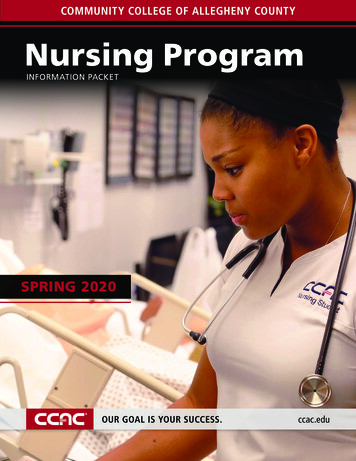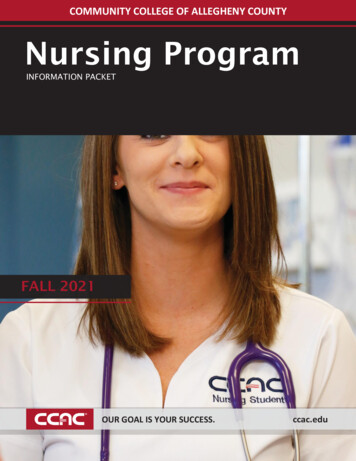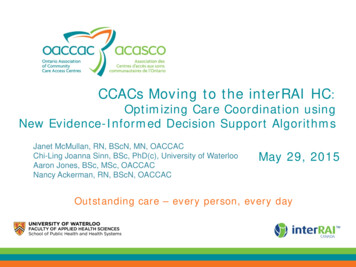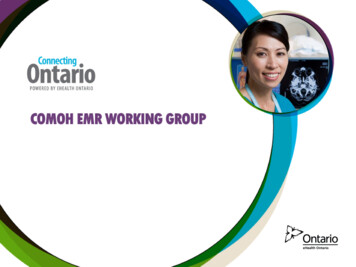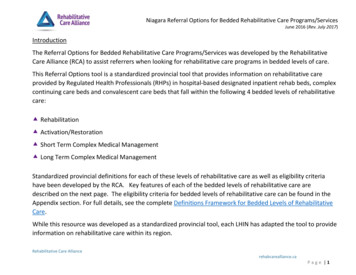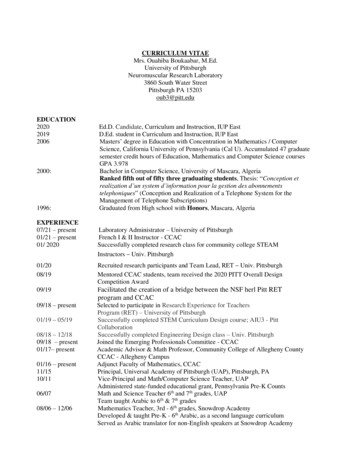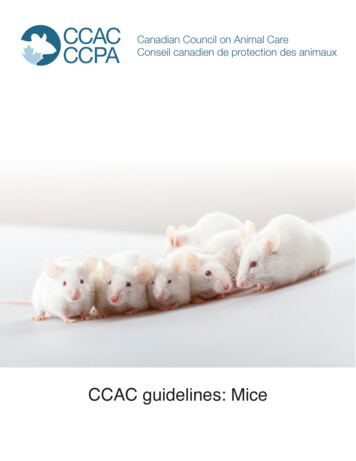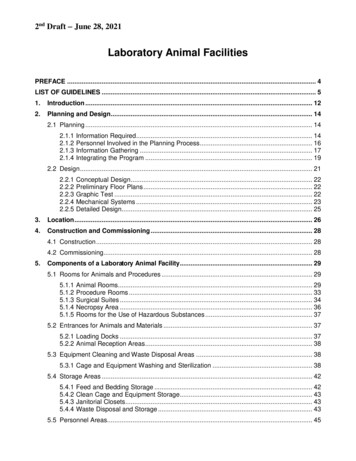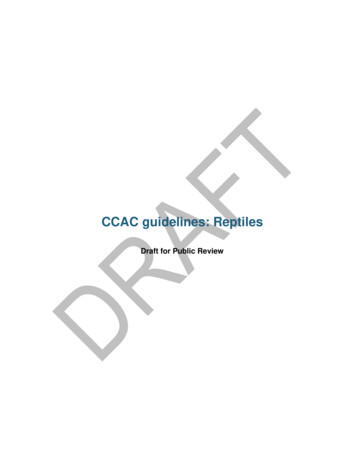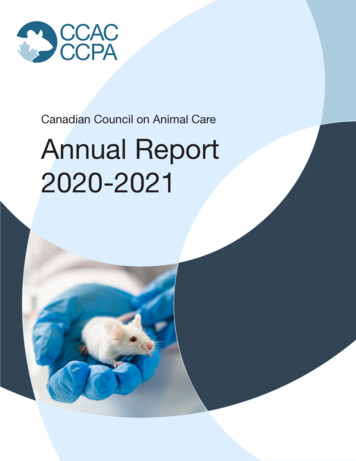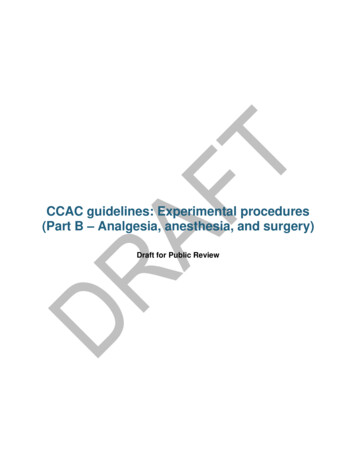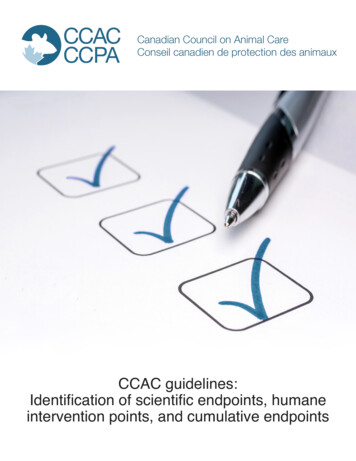
Transcription
CCACCCPACanadian Council on Animal CareConseil canadien de protection des animauxCCAC guidelines:Identification of scientific endpoints, humaneintervention points, and cumulative endpoints
Date of Publication: March 2022 Canadian Council on Animal Care, 2022ISBN: 978-0-919087-95-8190 O’Connor St., Suite 800Ottawa, Ontario, K2P 2R3http://www.ccac.ca
ACKNOWLEDGEMENTSThe Canadian Council on Animal Care (CCAC) Board of Directors is grateful for the expertise contributedby the members of the CCAC Subcommittee on Endpoints and for their engagement throughout the guidelines development process. In addition, the Board is grateful to all those who provided critical input duringthe two review periods. We would also like to acknowledge the contributions of both the CCAC StandardsCommittee and the CCAC Assessment and Certification Committee members, who provided importantguidance to the subcommittee. Finally, we would like to thank the CCAC Secretariat project team for itsexcellent work throughout this process. The CCAC also acknowledges its funders, the Canadian Institutes ofHealth Research and the Natural Sciences and Engineering Research Council of Canada. The CCAC couldnot continue to deliver on its current mandate without their support.Dr. Michael CzubrytChair, CCAC Board of DirectorsCCAC ENDPOINTS SUBCOMMITTEEDr. David Hanwell (Chair), University of TorontoDr. Shawn Davis, University of Toronto MississaugaMr. Ryan Hill, Fleming CollegeDr. Christine MacWilliams, Fisheries and Oceans CanadaMs. Annette Morrison, University of GuelphDr. Karen Schwartzkopf-Genswein, Agriculture and Agri-Food CanadaMs. Andree Shore, University of TorontoDr. Ian Welch, University of British ColumbiaDr. Gordon Winocur, Trent University and the University of TorontoDr. Andrew Winterborn, Queen’s UniversityMr. Pierre VerreaultCCAC Executive Director
Table of ContentsTABLE OF CONTENTSPREFACE.1LIST OF GUIDELINE STATEMENTS IN THIS DOCUMENT.21. INTRODUCTION.42. PROCESS FOR SETTING AND MONITORING SCIENTIFIC ENDPOINTS ANDHUMANE INTERVENTION POINTS.62.12.22.3Before Starting the Scientific Activity. 72.1.1 Choose the Scientific Endpoints. 72.1.2 Choose the Humane Intervention Points. 82.1.3 Organize the Animal Monitoring Regime. 9During the Scientific Activity. 102.2.1 Monitor Animals Throughout the Scientific Activity. 102.2.2 Ensure Consistency in the Application of the Scoring Sheet or Checklist(Inter-Observer Reliability). 102.2.3 Apply Interventions as Required. 102.2.4 Adapt Scientific Endpoints and Humane Intervention Points as Requiredin the Event of Unexpected Outcomes. 112.2.5 Keep Records . 11After the Scientific Activity Is Complete: Retrospective Analysis. 122.3.1 Evaluate the Effectiveness of the Scientific Endpoints and HumaneIntervention Points. 122.3.2 Use this Information in the Future. 133. CUMULATIVE ENDPOINTS.143.13.2General Guidance on Decision-Making Regarding Cumulative Endpoints. 14Additional Guidance for Common Cumulative Endpoint Contexts. 153.2.1 Breeding Animals. 163.2.2 Teaching and Training. 163.2.3 Aging and Longevity Studies. 17REFERENCES.18CCAC guidelines: Identification of scientific endpoints, humane intervention points,and cumulative endpointsi
Table of ContentsAPPENDIX 1EXAMPLES.20APPENDIX 2EXAMPLE HUMANE INTERVENTION POINT MONITORING TEMPLATE FORMICE USED IN CANCER RESEARCH.34GLOSSARY.39CCAC guidelines: Identification of scientific endpoints, humane intervention points,and cumulative endpointsii
PrefaceIdentification of scientificendpoints, humaneintervention points, andcumulative endpointsPREFACEThe Canadian Council on Animal Care (CCAC) is the national peer-review organization responsible forsetting, maintaining, and overseeing the implementation of high standards of ethical care and use of animalsin science throughout Canada.The CCAC guidelines: Identification of scientific endpoints, humane intervention points, and cumulative endpoints is part of a series of general guidelines documents that outline principles for the ethical care and use ofall animals in science. This series streamlines information for investigators, study directors, instructors, animalcare committees, facility managers, veterinarians, and animal care personnel to help facilitate improvement inboth the care given to animals and how experimental procedures are carried out. More specific informationon humane interventions can be found in the CCAC guidelines developed for specific types of animals.This guidelines document applies to all animals used for scientific purposes, including wildlife brought intolaboratory animal facilities and third-party-owned animals that are used off-site (e.g., at commercial farmsor shelters).These guidelines describe current standards and processes for identifying scientific endpoints, humane intervention points, and cumulative endpoints. The individual guideline statements in the document havebeen developed based on expert peer advice and current interpretation of scientific evidence.CCAC guidelines are intended to provide a framework for implementing Russell and Burch’s Three Rs:Replacement, Reduction, and Refinement (Russell and Burch, 1959), primarily the principle of Refinement.These practices are constantly evolving, and refinements should result in continual improvement in animalwelfare.For studies outside of Canada, investigators based at CCAC-certified institutions are subject to these guidelines and the relevant legislation and regulations pertaining to ethical animal care and use in the countrywhere the study is conducted.CCAC guidelines: Identification of scientific endpoints, humane intervention points,and cumulative endpoints1
List of Guideline Statements in This DocumentLIST OF GUIDELINE STATEMENTSIN THIS DOCUMENTThe following list of guideline statements serves as an executive summary covering the most importantaspects of identifying scientific endpoints, humane intervention points, and cumulative endpoints. Theseguideline statements are included throughout this document alongside details and references that providesupport and context for their implementation. Throughout this document, the term ‘should’ is used to indicate an obligation, for which any exceptions must be justified to, and approved by, an animal care committee.The term ‘must’ is used for mandatory requirements.2. PROCESS FOR SETTING AND MONITORING SCIENTIFIC ENDPOINTS ANDHUMANE INTERVENTION POINTSGuideline 1The scientific endpoints, humane intervention points, and monitoring regime must be described in a protocoland approved by an animal care committee before commencing any animal-based scientific activity. Thisinformation should be easily accessible to everyone working with the animals.Section 2.1 Before Starting the Scientific Activity, p.7Guideline 2When there is insufficient evidence to establish scientific endpoints prospectively, pilot studies must beconducted to identify the earliest point that the scientific activity can be terminated. Pilot studies must focuson determining welfare-appropriate endpoints, not on generating useable scientific data. The results of thepilot must be presented to the animal care committee before the protocol proceeds.Section 2.1.1 Choose the Scientific Endpoints, p.7Guideline 3Animals must be monitored for the duration of the protocol. Interventions must be applied when animalsreach a humane intervention point. To safeguard animal welfare, the chosen humane intervention pointsand scientific endpoints may need to be adjusted during a scientific activity; changes to these points shouldbe incorporated as amendments to protocols.Section 2.2 During the Scientific Activity, p.10Guideline 4A review of the effectiveness of the humane intervention points and scientific endpoints should occur when ascientific activity is completed. Any potential refinements should be included in future protocols (includingrenewals) and standard operating procedures (SOPs).Section 2.3 After the Scientific Activity is Complete: Retrospective Analysis, p.12CCAC guidelines: Identification of scientific endpoints, humane intervention points,and cumulative endpoints2
List of Guideline Statements in This Document3. CUMULATIVE ENDPOINTSGuideline 5Cumulative endpoints must be considered for all animals held long-term and for animals that have multiplescientific experiences, as described by the policy set by the animal care committee. These animals must havelifetime experience records that are updated as necessary and reviewed at regular intervals. The currentwelfare status of each animal should also be assessed regarding its continued use in science (includingteaching and training) before protocol renewal or approval of the use of each animal in a new protocol.Section 3.1 General Guidance on Decision-Making Regarding Cumulative Endpoints, p.14Guideline 6In certain types of studies (e.g., longevity studies), cumulative endpoints must inform the scientific endpointsas there is the potential for the cumulative endpoints to be reached before a desired scientific endpoint.Section 3.2.3 Aging and Longevity Studies, p.17CCAC guidelines: Identification of scientific endpoints, humane intervention points,and cumulative endpoints3
Section 1 – Introduction1INTRODUCTIONThroughout this document, the term ‘should’ is used to indicate an obligation, for whichany exceptions must be justified to, and approved by, an animal care committee. Theterm ‘must’ is used for mandatory requirements.Animals may have their welfare compromised during scientific activities (i.e., research, teaching, training,and testing) conducted in the pursuit of benefits to humans, animals, or the environment. These guidelinesaim to provide information so that animal care committees, animal health professionals, researchers, andinstructors can work collaboratively to reduce potential welfare impacts through the judicious use of scientific endpoints, humane intervention points, and cumulative endpoints.The term ‘scientific endpoints’ describes the earliest points at which the stated objectives of the scientificactivity will be reached (e.g., collection of data or biological materials over a predetermined time, achievinglearning outcomes). Protocol authors have an ethical responsibility to identify the earliest possible scientificendpoints to reduce the welfare impact to the animals; this includes recognizing when the scientific activity is not working as intended and thus should be halted. There remains a clear need for validation of earlypredictors of the scientific endpoint in many research models. Protocol authors must stay current withvalidated scientific endpoints in their field of study and include them in their protocols. Further, protocolauthors are encouraged to refine outcomes that advance validated endpoints within their area of expertisewhenever possible by attempting pilot or parallel studies with careful observation and welfare assessments.In contrast, the term ‘humane intervention points’ describes criteria (i.e., observable health impacts, physiological changes, or behavioural signs) that when met, require an intervention to address negative welfarestates. This term is used instead of ‘humane endpoints’ to indicate that action is to be taken to protect animalwelfare, but this action is not necessarily euthanasia. Thus, possible interventions progress in range fromchanging an animal’s physical or social environment; providing supportive care (e.g., suspend handling,give hydration and nutritional support); treating infections with antibiotics; providing pain relief; removing individual animals from the scientific activity temporarily (or permanently if their condition fails toimprove); to euthanasia if the welfare impact has exceeded the expected severity, or the scientific benefitno longer justifies the welfare impact. For consistency with the Three Rs, welfare-protecting interventionsmust occur as early as possible. These intervention points must be documented and tailored to the specificprotocol through careful consultation between the protocol author and those charged with attending to thewell-being of the animals, and modified as needed. Humane intervention point monitoring may requirespecialized training, or awareness of any specific concerns, related to the design of the scientific activity, andwelfare-monitoring personnel must be deemed competent.It is important to note that in addition to anticipated humane intervention points, there may be unexpectednegative outcomes (e.g., unrelated illness, life support systems failure, unexpected adverse effects of thescientific activity). These may or may not be related to the specific scientific procedure and may warrantCCAC guidelines: Identification of scientific endpoints, humane intervention points,and cumulative endpoints4
Section 1 – Introductionhumane interventions before scientific endpoints are achieved. Welfare-monitoring personnel need to beskilled, flexible, and adaptive to ensure humane intervention points are applied in these circumstances.Appropriately chosen humane intervention points can improve research quality and reproducibility byavoiding secondary complications and pathologies (e.g., increases in blood pressure, gastrointestinal distress, unexplained loss of weight or body condition, changes to blood glucose levels, abnormal behaviour).Humane intervention points should be reproducible and minimize welfare impacts. Thus, humane intervention points should be: objective and measurable (to reduce ambiguity or observer subjectivity); detectable prior to the onset of negative welfare states; and based on specific observable health impacts, physiological changes, or behavioural signs1.In light of current scientific evidence, these guidelines have been expanded to acknowledge the psychological impact of scientific procedures and other ‘whole life’ experiences (e.g., social isolation, marking foridentification, under-stimulating environments) on animals. Thus, regarding limits to the long-term or repeated involvement of individual animals in scientific activities, these guidelines use the term ‘cumulativeendpoints’. This term describes the threshold values when procedures should be discontinued and the useof the animals in scientific activities ended, preferably before unexpected welfare impacts are apparent.This threshold value is determined by considering the aggregate impact of all welfare-impacting proceduresan animal has experienced over its lifetime (see the CCAC guidelines: Animal welfare assessment (CCAC,2021)). All previous welfare impacts must be considered when thinking about an animal’s cumulative lifetime experiences. To ensure that compromises to animal welfare do not exceed those approved by an animalcare committee, those involved with the scientific activity and animal care have an ethical obligation toidentify as early as possible animals that are no longer coping with life as a scientific subject (e.g., failure togroom, abnormal appearance, loss of appetite, stereotypic behaviour, exaggerated responses to routine procedures, continually fighting restraint).Animals should not be held indefinitely without a clear purpose and defined plan. If animals will be placedon holding protocols between scientific activities, their prospective use should be reviewed periodically toensure that they are not being held unnecessarily. Furthermore, the time spent on holding protocols must beincluded in cumulative endpoint assessments.It is essential that humane intervention points and scientific endpoints are defined, established, and writteninto every animal care committee-approved protocol before commencing any scientific work (see CCACpolicy statement on: terms of reference for animal care committees). It is also important to note that theseguidelines apply to all scientific activities within the CCAC’s mandate, regardless of the expected welfareimpact (see Requirement for Submitting an Animal Protocol: Addendum to the CCAC policy statement onterms of reference for animal care committees (CCAC, 2020)).1 As opposed to only listing negative affective states (e.g., fear and anxiety). Validated indicators are used to infer affective states,and thus a clear description of the indicator should be used to identify the situation and intervention (CCAC guidelines: Animalwelfare assessment (CCAC, 2021)).CCAC guidelines: Identification of scientific endpoints, humane intervention points,and cumulative endpoints5
Section 2 – Process for Setting and Monitoring Scientific Endpoints and Humane Intervention Points2PROCESS FOR SETTING AND MONITORINGSCIENTIFIC ENDPOINTS AND HUMANEINTERVENTION POINTSThe guidance provided in this section follows typical steps for planning and conducting a scientific activity.It is intended to offer a framework for effective implementation and assessment of scientific endpoints andhumane intervention points.Implementation of scientific endpoints and humane intervention points should follow a cyclical path(Figure 1). Specifically, once the planning and conduct of the scientific activity are complete, there should bereviews of the effectiveness of the chosen scientific endpoints and humane intervention points (see Section2.3, “After the Scientific Activity is Complete: Retrospective Analysis”). The goal of this review is to incorporate refinements in future iterations of the scientific activity (e.g., when renewing a protocol or planninganother trial with similar procedures). Additional guidance regarding cumulative or long-term animal usecan be found in Section 3, “Cumulative Endpoints”. Examples of implementing scientific endpoints and humane intervention points in specific contexts can be found in Appendix 1.2.1 Before Starting theScientific Activity Choose the scientific endpoints Choose the humane intervention pointsand associated interventions Develop the animal monitoring regime2.3 After the ScientificActivity is Complete:Retrospective Analysis2.2 During the Scientific Activity Monitor animals as they progressthrough the scientific activity Ensure consistency in the application ofany scoring sheets or checklists used Apply interventions as required Adapt scientific endpoints and humaneintervention points as required in theevent of unexpected outcomes Keep records Evaluate the effectiveness of thescientific endpoints and humaneintervention points Use this information in the futureFigure 1: Overview of the process for setting and implementing scientific endpoints and humaneintervention pointsCCAC guidelines: Identification of scientific endpoints, humane intervention points,and cumulative endpoints6
Section 2 – Process for Setting and Monitoring Scientific Endpoints and Humane Intervention Points2.1BEFORE STARTING THE SCIENTIFIC ACTIVITYGuideline 1The scientific endpoints, humane intervention points, and monitoring regime must bedescribed in a protocol and approved by an animal care committee before commencingany animal-based scientific activity. This information should be easily accessible toeveryone working with the animals.2.1.1Choose the Scientific EndpointsGuideline 2When there is insufficient evidence to establish scientific endpoints prospectively, pilotstudies must be conducted to identify the earliest point that the scientific activity can beterminated. Pilot studies must focus on determining welfare-appropriate endpoints, noton generating useable scientific data. The results of the pilot must be presented to theanimal care committee before the protocol proceeds.Definition: Scientific endpoints are the earliest points at which the approved objectives of the scientific activity can be achieved while also ensuring that the welfare impact experienced by the animals is minimized.When the scientific endpoints are reached, the approved live animal use is complete.The protocol author is responsible for proposing the scientific endpoints, as they are in the best positionto determine when the goal of the scientific activity will be reached. However, protocol authors should beexpected to justify their chosen scientific endpoints by pointing to relevant scientific literature, pilot studies,correspondence with colleagues, or previous work in their laboratory. In the absence of evidence, a reasonable justification should be made that is consistent with the definition of ‘scientific endpoint’ above. Wherethere is insufficient knowledge available to establish endpoint criteria, pilot studies must be conducted toidentify the earliest scientific endpoint that will result in minimal welfare impacts for the animals in thefull study. Protocol authors should also keep up with all developments of earlier scientific endpoints fortheir specific field of study (e.g., Collymore et al., 2018; Oliveira et al., 2017). Protocol authors are stronglyencouraged to confirm earlier scientific endpoints in the experimental process through validation studieswhenever possible (i.e., improve best practices).Scientific endpoints are based on the scientific question being asked, the objective of the scientific activity,and the approved limits of impact to animal welfare. Scientific endpoints can be described in different termsdepending on the specific scientific activity. For example, these endpoints may be described temporally (i.e.,a specified duration), in health-related terms (e.g., a limit to disease progression), or in terms of specificobjectives (e.g., students achieving learning outcomes, animals completing a certain number of behaviouraltests, reaching maximum attainable growth of a tumour). In some cases, analyzing data as the experimentproceeds (rather than at the end) could result in the determination of an earlier scientific endpoint.Scientific endpoints and their impacts on animal welfare will vary across many factors such as species, procedures, and protocol objectives. This means that the appropriateness of each scientific endpoint should beCCAC guidelines: Identification of scientific endpoints, humane intervention points,and cumulative endpoints7
Section 2 – Process for Setting and Monitoring Scientific Endpoints and Humane Intervention Pointsweighed within the context of the protocol, and that generic approaches are unlikely to be effective (e.g., dueto model, species, strain, or sex differences). In certain types of studies (e.g., longevity studies), cumulativeendpoints must also be considered when determining the scientific endpoints (see Section 3.2.3, “Aging andLongevity Studies”). An example of determining scientific endpoints is provided in Appendix 1.Ultimately, if an animal care committee thinks that the chosen scientific endpoints are not appropriate, thecommittee must not approve the work as described (see CCAC policy statement on: terms of reference foranimal care committees). Studies should not be approved if the animals are not likely to reach the scientificendpoint; for example, if it is expected that the animals will have to be euthanized before the stated aims ofthe scientific activity can be achieved.2.1.2Choose the Humane Intervention PointsDefinition: Humane intervention points are the pre-established criteria (e.g., observable health impacts,physiological changes, behavioural signs) that indicate when an intervention (e.g., supportive care, analgesia, euthanasia) should occur in order to reduce welfare impacts to a level that has been approved by theanimal care committee.Rather than describing when the scientific activity will end, humane intervention points indicate when oneshould intervene in the scientific activity for humane reasons. Examples of humane intervention pointsmight be ‘cats not eating the test diet for more than 48 hours will be provided supplemental canned diet’,‘dogs reaching a lameness score of 4 out of 5 will receive analgesia’, or ‘when wound breakdown occurs, treatment is needed’. Humane intervention points should be established through consultation between scientific and veterinary personnel, referencing scientific literature, pilot studies, or, if necessary, expert opinion.Appropriate interventions should minimally interfere with the scientific aims of the study; interventionsthat are mutually acceptable to the veterinarian and the protocol author must be sought. Generally, theveterinarian-recommended interventions should be followed unless the protocol author can demonstratethat the action will definitively compromise the integrity of the data (in which case, other interventions mustbe sought). Consideration should be given to the relative impacts of performing and withholding interventions (Peterson et al., 2017). Ultimately, all humane interventions must be approved by the veterinarian, andif mutually agreeable interventions cannot be found, the protocol must not be approved.As with scientific endpoints, humane intervention points and associated interventions will be protocol specific and should be evaluated within the context of the described scientific activity. For example, some studies require an impact on animal welfare as part of the model. In such cases, protocol authors and veterinaryand animal care personnel should consult with one another to ensure the scientific aims can be achievedwith the minimum amount of welfare impact to the animal. In other cases, a much smaller amount ofimpact might be acceptable before interventions are applied. The end goal of humane intervention pointsshould be to achieve the scientific endpoints with the least amount of impact on animal welfare. Care mustalso be taken to ensure that the welfare impacts of the interventions themselves are minimized (includingimpacts on any conspecifics housed with the target individual). It is essential that the scientific team andveterinary personnel work together to decide on humane intervention points before any work commences,so that there are no issues or delays with the appropriate course of action while an animal is experiencingcompromised welfare. If the protocol author would like samples to be saved from any animals that have tobe euthanized, this should be planned beforehand.CCAC guidelines: Identification of scientific endpoints, humane intervention points,and cumulative endpoints8
Section 2 – Process for Setting and Monitoring Scientific Endpoints and Humane Intervention PointsThe need to describe humane intervention points applies equally to the use of animals in teaching and training situations. The expectation is that these humane intervention points are described in teaching protocolswith as much rigour as in research protocols. Students and trainees are encouraged to learn how to monitorbehavioural changes (e.g., decreased mobility and grooming, aggressiveness) that reflect welfare impactsin the animals they are using. However, the responsibility for monitoring and implementing any requiredhumane interventions must always lie with the protocol author (who may or may not be the competentinstructor), not the learners.2.1.3Organize the Animal Monitoring RegimeA clear plan must be in place regarding the documented monitoring of each animal (or group of animals,as necessary) as it progresses through the scientific activity. The protocol must clearly identify those responsible for monitoring the animals. The responsible individuals must demonstrate knowledge of the clinicalsigns of any expected negative health conditions or physiological changes and the behavioural signs of impaired welfare for that species. Monitoring animals is a joint responsibility shared by the scientific team, veterinarian, and animal care personnel. Planning, good communication, and transparency are key to effectivemonitoring and early detection of concerns. The protocol author and veterinary team should develop clear,objective welfare assessment criteria together. Once the animal care committee has approved these criteria,the protoco
The Canadian Council on Animal Care (CCAC) is the national peer-review organization responsible for setting, maintaining, and overseeing the implementation of high standards of ethical care and use of animals in science throughout Canada. The CCAC guidelines: Identification of scientific endpoints, humane intervention points, and cumulative end-
